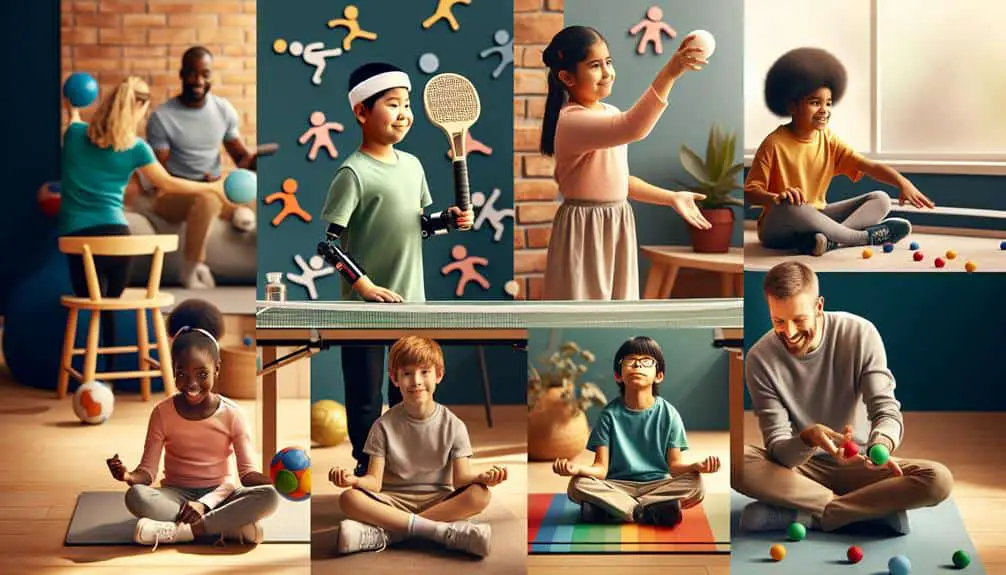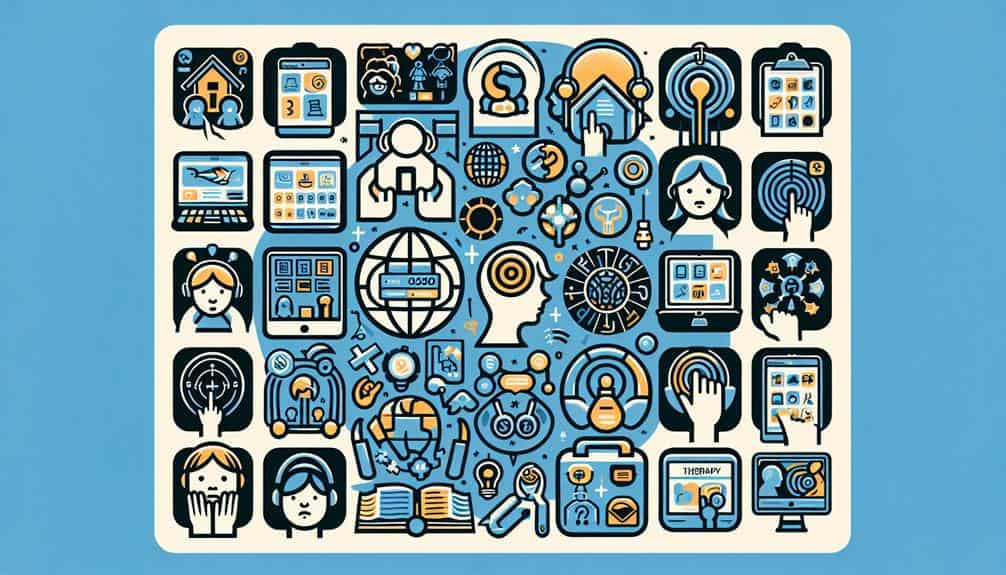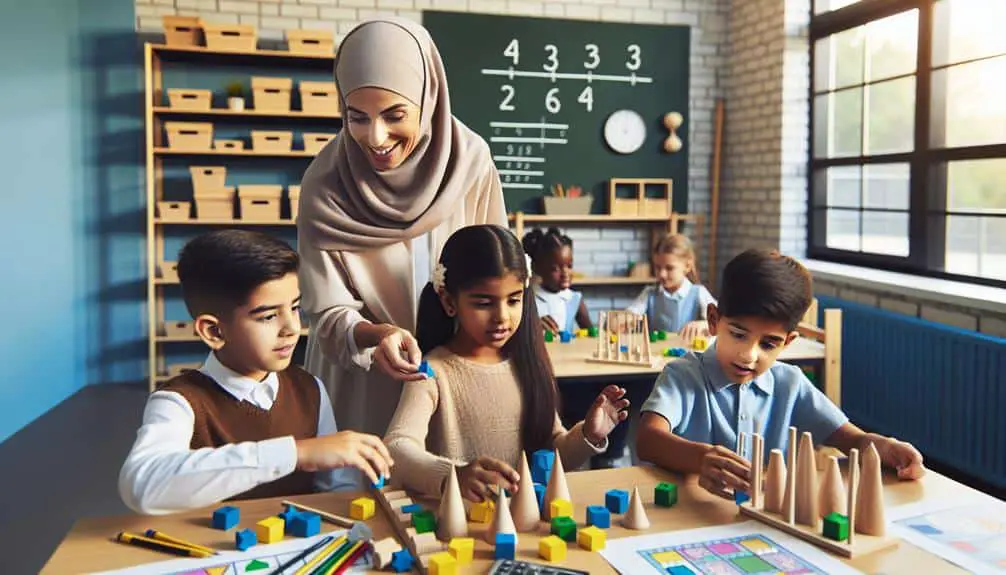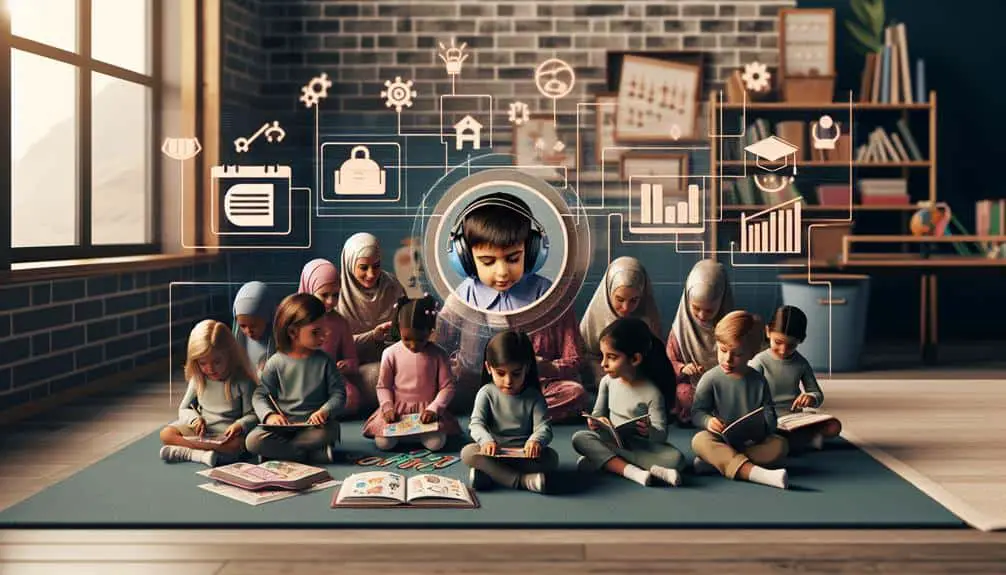Adapting PE for special needs homeschoolers means tailoring activities to fit unique abilities and sensory preferences. Create a supportive environment and celebrate progress. Involve parents and seek guidance from therapists. Use visual supports and adjust equipment for safety. Incorporate sensory activities to enhance the experience. Focus on individualized routines and goals for growth. Evaluate progress regularly and adjust as necessary to guarantee continued development. Your approach should be inclusive and understanding of each child's needs. Keep in mind their strengths and challenges for a successful PE program that caters to their specific requirements.
Key Points
- Tailor PE activities to individual abilities and interests for effective engagement.
- Incorporate sensory activities to support well-being and sensory needs.
- Involve parents in creating and implementing adaptive PE programs.
- Consult with therapists or educators for tailored modifications and accommodations.
- Celebrate small victories, set personalized goals, and adjust routines based on progress.
Understanding Special Needs in PE
Understanding the special needs of your child in physical education is vital for creating a supportive and effective homeschool PE program. When designing activities for your child, consider their sensory integration needs. Some children may be sensitive to loud noises or bright lights, which could impact their participation in certain physical activities. By being aware of these sensitivities, you can create a more comfortable environment for them to engage in PE.
Moreover, it's important to recognize the physical challenges your child may face. For instance, some children might've difficulties with coordination or balance, making certain exercises more challenging. By acknowledging these challenges, you can tailor your PE program to include activities that help improve these skills gradually.
Remember, progress may take time, and it's crucial to be patient and encouraging throughout the process. Celebrate small victories and provide positive reinforcement to motivate your child to keep trying their best.
Creating Adaptive PE Programs
Consider adapting your PE program by incorporating modifications and accommodations to meet the unique needs of your child with special needs. Parent involvement is essential in designing a program that suits your child's abilities and interests.
Start by consulting with your child's therapist or special education provider to understand what modifications can be made to exercises. Creative adaptations, such as using visual supports, timers, or alternative equipment, can make activities more accessible.
Inclusive activities are vital for an adaptive PE program. Look for activities that can be easily modified to accommodate your child's needs while still providing a fun and engaging experience. Encouraging social interaction through team sports or group exercises can also help build important social skills.
Exercise modifications should focus on your child's strengths and interests while gradually introducing new challenges. By incorporating a variety of activities that cater to different abilities, you can create a well-rounded PE program that promotes physical fitness and overall well-being for your child with special needs.
Incorporating Sensory Activities
To enhance your adaptive PE program for special needs homeschoolers, incorporating sensory activities can provide additional opportunities for engagement and development. Sensory integration plays an important role in the overall well-being of individuals with special needs, as it helps regulate their responses to stimuli. By incorporating sensory activities into your PE routine, you can create a more inclusive and beneficial experience for your homeschooler.
Utilizing therapy resources designed for sensory integration can be incredibly valuable. Tools like sensory balls, textured mats, or even simple items like bean bags can add a tactile element to your activities. These resources can help improve your homeschooler's coordination, balance, and overall sensory processing skills.
When incorporating sensory activities, it's crucial to observe your homeschooler's responses and adjust the activities accordingly. Remember that every individual is unique, and what works for one may not work for another. By being attentive and flexible, you can create a stimulating and effective PE program that caters to your homeschooler's specific sensory needs.
Choosing Suitable Equipment
When selecting equipment for your special needs homeschooler's physical education activities, consider their individual abilities and interests to guarantee engagement and success.
It's important to adapt equipment to accommodate any disabilities or sensory sensitivities to create a safe and enjoyable experience.
Prioritize safety by choosing equipment that's age-appropriate, durable, and suitable for your child's unique needs.
Equipment Selection Tips
Selecting the right equipment for your special needs homeschooler's physical education activities is crucial for their comfort and safety. When choosing equipment, consider various factors to guarantee it meets your child's unique needs.
Here are some tips to help you make the best selections:
- Explore Budget-Friendly Options: Look for cost-effective equipment that still provides quality and safety for your child.
- Consider Specialized Gear: Invest in equipment specifically designed to cater to your homeschooler's individual requirements.
- Seek Custom Modifications: Explore options for adapting standard equipment to better suit your child's needs.
- Opt for Versatile Tools: Choose equipment that can be used in multiple ways to engage your child in various physical activities.
- Prioritize Safety and Comfort: Make sure that the equipment you select prioritizes your child's safety and comfort during physical education sessions.
Adaptation for Disabilities
Consider adapting equipment for disabilities by exploring specialized options designed to accommodate your child's unique physical needs.
Inclusive modifications can make a significant difference in creating a positive and engaging physical education experience. Look for equipment that can be adjusted in height, width, or resistance to suit your child's abilities.
Tailored exercises tailored to your child's specific needs can help them participate fully and enjoy the benefits of physical activity.
Interactive games offer a fun way to engage in physical education while promoting social interaction and teamwork. These games can be adapted to accommodate different abilities and provide personalized challenges for your child.
By choosing equipment and activities that cater to your child's disabilities, you can create a safe and supportive environment for them to thrive in their physical education journey.
Safety Considerations
To guarantee a safe and beneficial physical education experience for your special needs homeschooler, it's important to carefully choose equipment that suits their unique abilities and limitations.
- Safety Guidelines:
Always follow safety guidelines specific to your child's needs.
- Parent Supervision:
Ensure constant supervision during physical activities.
- Equipment Precautions:
Check equipment for any defects or potential hazards before each use.
- Emergency Plans:
Have clear emergency plans in place and communicate them with your child.
- Adaptability:
Choose equipment that can be easily modified to accommodate your child's needs.
When selecting equipment, prioritize safety and functionality. Consider the specific requirements of your child's condition and choose items that promote both safety and engagement.
Remember that your presence and attention are essential in ensuring a secure environment for your special needs homeschooler. By being proactive in equipment selection, adhering to safety guidelines, providing supervision, and having emergency plans in place, you can create a positive and secure physical education experience tailored to your child's unique needs.
Modifying Traditional PE Exercises
Let's explore how you can adapt traditional PE exercises to better suit the needs of your special needs homeschooler.
By making equipment adaptations, creating individualized routines, and incorporating sensory-friendly activities, you can guarantee a successful and enjoyable physical education experience.
Equipment Adaptations
Adapt traditional PE exercises by modifying equipment to better suit the needs of special needs homeschoolers. Making simple adjustments to equipment can make physical activities more accessible and enjoyable for everyone.
Here are some ways you can modify equipment to better accommodate special needs:
- Safety modifications: Adding non-slip grips to handles or using foam padding on edges can help prevent accidents and injuries during exercise.
- Sensory equipment: Incorporating sensory-friendly equipment like textured balls or balance boards can provide additional sensory input for a more engaging workout.
- Budget-friendly options: Look for cost-effective alternatives such as using household items like towels as resistance bands or repurposing old tires for obstacle courses.
- DIY adaptations: Get creative by repurposing items around the house to create custom equipment tailored to your child's needs, like using PVC pipes to make agility poles or buckets for target practice.
- Adjustable features: Opt for equipment with adjustable heights, weights, or resistance levels to cater to different abilities and promote inclusivity in your physical education sessions.
Individualized Routines
Consider tailoring traditional PE exercises to fit the unique abilities and preferences of each special needs homeschooler, ensuring a personalized and engaging fitness experience. Personalized schedules play an essential role in accommodating the diverse needs of special needs homeschoolers. Create routines that align with their energy levels, attention spans, and overall well-being. By tailoring activities to match their interests and abilities, you can enhance their motivation and enjoyment of physical education.
When designing individualized routines, focus on incorporating tailored activities that cater to the specific needs of each homeschooler. Adapt exercises to accommodate their strengths and challenges, ensuring a positive and inclusive experience. Encourage participation by introducing activities that align with their sensory preferences and comfort levels.
Sensory-Friendly Activities
To create sensory-friendly activities, you can modify traditional PE exercises to cater to the unique sensory needs of special needs homeschoolers. Understanding and adapting activities can make physical education enjoyable and beneficial for all.
Here are some ways to make PE more sensory-friendly:
- Incorporate sensory exploration: Allow for different textures, sounds, and visuals during exercises to engage multiple senses.
- Provide movement breaks: Include short, structured breaks in between activities to help regulate sensory input and keep participants focused.
- Use visual schedules: Display a visual plan of the PE session to help individuals anticipate changes and activities.
- Offer choice: Provide options for equipment, activities, or locations to accommodate individual sensory preferences.
- Encourage self-regulation: Teach coping strategies like deep breathing or sensory tools to help students manage their sensory needs during PE.
Implementing Individualized Goals
As you guide your special needs homeschooler through Physical Education, focus on setting specific and tailored goals to foster their growth and development. Goal setting is vital in helping your child progress in their physical abilities. Start by identifying areas where they can improve and setting realistic objectives. These goals should be personalized to your child's needs, ensuring that they're challenging yet achievable.
Incorporate personalized exercises that cater to your child's unique strengths and challenges. By tailoring the activities to their abilities, you can help them develop new skills while also building on existing ones. Progress tracking is essential to monitor how your child is advancing towards these goals. Keep a record of their achievements and celebrate their successes along the way.
Focus on skill development by breaking down larger tasks into smaller, more manageable steps. This approach can help your child make steady progress and stay motivated. Remember, each child progresses at their own pace, so be patient and supportive throughout their PE journey.
Evaluating Progress and Adjusting
Monitoring your child's advancements in Physical Education and making necessary adjustments is essential for their continued growth and development. Tracking milestones and adjusting techniques along the way will help guarantee that your child is progressing effectively.
Here are some tips to help you evaluate progress and make the necessary adjustments:
- Regular Assessments: Conduct periodic assessments to track your child's progress and identify areas that may need improvement.
- Communication: Keep an open line of communication with your child to understand their experiences and challenges during PE sessions.
- Consulting Professionals: Seek advice from healthcare providers or therapists to get insights on how to adjust techniques based on your child's specific needs.
- Setting New Goals: Based on the progress made, set new achievable goals to keep your child motivated and engaged.
- Flexibility: Be open to modifying activities or approaches to cater to your child's changing abilities and interests.
Frequently Asked Questions
How Can I Make PE Fun for My Special Needs Homeschooler?
To make PE fun for your special needs homeschooler, try sensory activities like obstacle courses, inclusive games for socializing, creative movement to express themselves, and outdoor adventures for fresh air. Tailor activities to their interests and abilities.
What Are Some Ways to Motivate My Child During PE Sessions?
To motivate your child during PE sessions, consider implementing a reward system. Offer positive reinforcement for their efforts. Engage in creative activities and vary exercises to keep them interested. Remember, every small step forward is a success!
Are There Any Resources for Socializing Opportunities During Pe?
When looking for chances to socialize during PE, explore virtual meetups or in-person events tailored for special needs individuals. Consider joining sports clubs or group classes that foster connections and friendships through shared activities.
How Do I Handle Behavioral Challenges During PE Activities?
When handling behavioral challenges during PE activities, remember to focus on behavior management strategies. Implement positive reinforcement techniques such as praise and rewards. Set clear expectations, offer support, and be patient in guiding your child through positive interactions.
Can I Incorporate Therapy Exercises Into Our PE Routine?
Want to enhance your PE routine with therapy exercises? You can easily incorporate them, making personalized modifications as needed. These exercises can be beneficial, offering movement breaks that cater to individual needs and goals.



